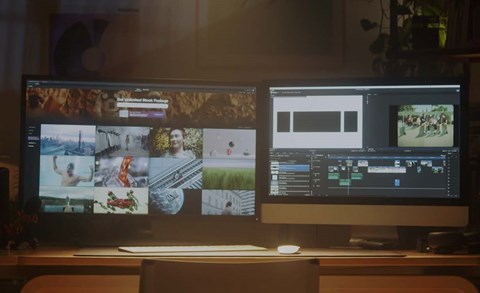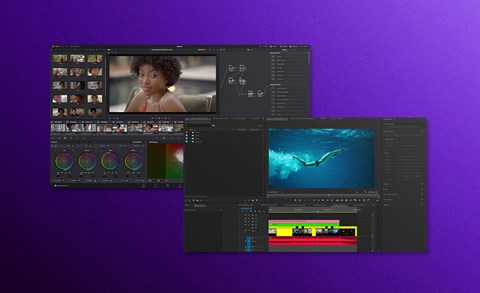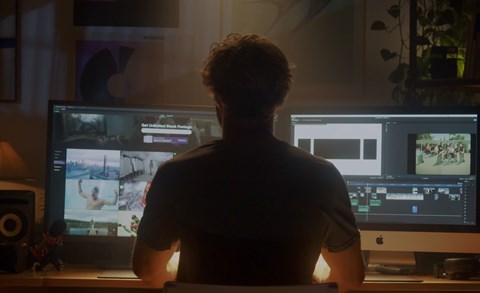If you’re considering becoming a Professional Video Editor, there are several things you should consider. Working in the fast-paced world of filmmaking can be challenging and rewarding in equal measure. In this guide, we will look at how to become a video editor - from deciding what kind of video content you want to edit to getting paid as a professional Film Editor.
Part 1: Do you want to be a video editor?
Before getting into video editing, the first question you need to consider is, do you want to be a professional video editor? Video editing is a skill honed over many years; as an editor, you will never stop learning or improving your skillset.
Becoming a professional editor can mean different things to different people. For some, professional video editing will mean working on films or TV shows; other professional editors focus on commercials and ad campaigns, then some work in digital marketing.
The workflow of a professional editor will depend mainly on what you are editing. Once you’ve chosen a particular path, it can be difficult to change direction, so think carefully about the types of projects you want to work on and specialize where you can.
Part 2: Learning video editing skills
Traditionally, an editor is someone that cuts together the film into a narrative structure. However, with easier access and more advanced technologies, editors are now expected to multitask, and video editing skills often include color correction, grading and animation within the same editing process.
Choosing your software
From Adobe Premiere Pro to the YouTube Editor, there are many different editing platforms available at a range of other price points. While it may be tempting to go for the most cost-effective, it is essential to recognize the differences in what the software offers. Do you want linear or non-linear editing? Do you want to work with Keyframe animation or add special effects to your film? Each platform has advantages and disadvantages, and it is worth putting the time into testing the workflow. Check out this list of the best video editing software for beginners and this DaVinci Resolve vs. Premiere Pro comparison post.
Top Tip: Take advantage of Freemium versions and free trials of the software to find what works best for you.
Skills

Once you’ve got your editing suite set up, you need to build your editing skills,.and stock footage is a great tool to start practicing your video editing skills. Using a stock library like Artgrid’s, which lets you use an unlimited number of clips for a fixed subscription fee; you can practice every stage of creating a video from scratch. You can imagine a client and search for footage to suit their brand or create a sci-fi trailer using stock footage in video. It will help you build your storytelling skills and find a workflow to suit your style.
Experience
As with many job roles, experience is important when applying for editing work. While editing with stock footage can help you build your skillset, real-world examples of your work are essential for potential employers to see.
Many would-be editors make the mistake of posting publicly online offering free video editing to build their showreel. While this is one way of gaining real-world experience, it is easy to be taken advantage of.
Instead, approach a small business that you like and present them with an idea for their video and offer to edit it together for them. By creating a clear brief at the start of the project, you’ll limit how much work the client expects while ensuring you have a finished video you’re proud to put your name on and add to your showreel.
Part 3: Getting work as a professional video editor
Once you’ve built your skillset to a satisfactory level and got a fantastic showreel to promote your services, you can start looking for professional editing work. However, it’s not as easy as it seems. One option is to start a video editor intern.
Workflow
The workflow with clients or creative partners is very different from working on your own. You will need to consider how many edits a client can have, how the edits will be provided for review and how the client can concisely offer feedback.
Sites like Motion Array offer excellent editing review capabilities, allowing your clients and team members to comment on your video edits. There are many ways to create a feedback process for your work; the key to a successful workflow is consistency and organization.
Another aspect that a lot of new editors forget is storage. Every project you work on will take up space on a hard drive. Of course, you can delete the project once completed, but it is always a good idea to hold on to client projects if there are any future changes. You must plan and charge for the safe storage of your projects and assets.
Getting video editing jobs
If you're wondering how much does a video editor make, there are loads of very talented editors out there looking for work so that competition can be fierce. Joining job boards and posting sites is an excellent way of finding and applying for entry-level editing work. There are also plenty of editing community groups on Facebook, Linkedin, and Reddit that can help you find your way.

Self-promotion can be difficult, which is why it is crucial to building a network of like-minded filmmakers. Remember, editing is only one step in the filmmaking process; making lasting connections with camera operators, DOPs, and even runners can help you find opportunities.
Getting paid
You’ve done all the work, found the client and produced a fantastic video; now, you just need to get paid.
Many editors are freelance, meaning they are contracted to individual projects and are paid for the duration of their work. Depending on where you're located in the world, working as a freelancer will have various tax and legal requirements; make sure you check the rules for freelancing in your area.
The last pitfall of the inexperienced editor is not saving costs. Whether it’s 1 year or 10 years into your editing career, you will at some point need to update your gear and software. Therefore, it is a great practice to put aside a portion of your earnings for investment in future equipment and ensure no interruption to your service if you run into computer troubles.
Conclusion
How to become a video editor professional might be a process, but for those that stick with it, the rewards are fantastic. Professional video editing allows for varied and exciting new projects and control over your work/life balance. Video editing can also be remote, making geography a non-issue and allowing you to work from where you like when you like.






